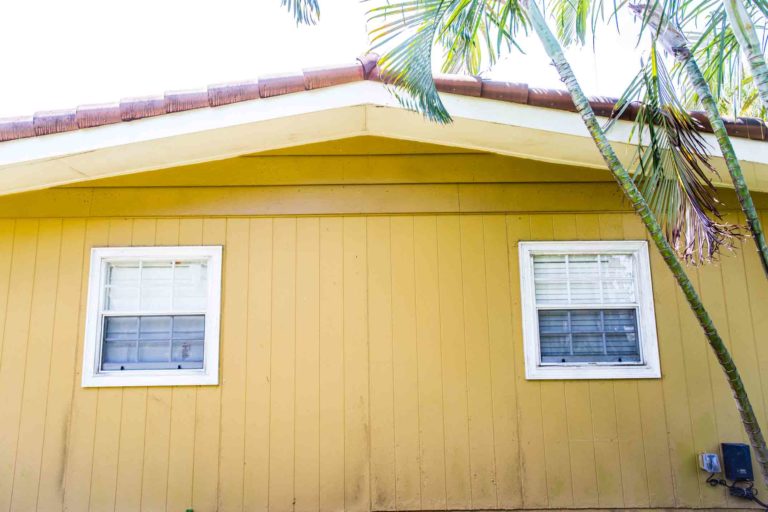Artistically rendered, precisely engineered, and professionally installed, your fiber cement siding can last the rest of your life. A few simple cleaning and maintenance measures are all that are needed to keep your siding looking great and protect your family from the elements year after year. James Hardie fiber cement siding offers the best combination of strength, resilience, and beauty, especially in South Florida’s harsh climate. Proper techniques and the use of approved cleaning products and methods not only will keep your home’s siding looking its best, but also ensure the manufacturer’s warranty will remain in full effect.

Dirt and Dust
Like our skin, your home’s exterior surface will encounter its share of grime simply by being exposed to rain, wind, and people. And like our cousin Festus, fiber cement siding needs a bath every six months or so. There are two ways to remove the everyday dirt that accumulates on siding panels. You can either “dust” the surface with a soft brush (we find that paintbrushes work best) and then rinse the area with a garden hose or you wet a soft cloth and wash the surface area.
Whichever method you choose, start at the top and work along each plank rather than across several planks at a time. Work in small sections, rinsing the cloth or beating out the brush frequently. Tougher stains like grease oil can be addressed by applying water and a mild detergent like dishwashing soap with a soft-bristled brush.
Never use acidic cleaners or high-pressure wash to clean your siding. If you chose primed siding and painted it after installation, refer to the paint manufacturer’s cleaning recommendations.
Mold, Mildew, and Algae
The region’s warmth and humidity make South Florida a paradise for mold and mildew. Cleaning these scourges from your fiber cement siding, however, needn’t be a major chore. The aim is to not only scrub the spores off the siding but also to lower the surface pH to make the panels less welcoming. Commercial siding cleaners work best, but you can make do with homemade recipes. After donning goggles, masks, and gloves, mix the store-bought cleaner, bleach, baking soda, ammonia, or salt into a bucket of water. Spray the solution onto the siding, let it work for several minutes, then rinse it off with plain water at low pressure. Repeat as necessary.
Preventative Measures
Protecting your siding from natural and human-made hazards will reduce the time you must spend on maintenance and minor repairs. After all, an ounce of prevention is worth a pound of cure.
Water, whether it falls from the sky or flows from a spigot, carries plenty of particles that remain on siding surfaces after it dries. Keeping rain, puddle splashes, and sprinkler spray off your siding reduces the amount of dirt that can accumulate. Start by making sure rainwater gets channeled away from your home’s siding. Properly installed gutters and downspouts will prevent dirty runoff from cascading down the exterior walls and causing streaks. Regularly check these components to remove leaves and other detritus that can clog the pipes and allow dirty water to spill over and run down the siding. Likewise, adjust sprinklers to ensure they do not continually spray water onto the siding where it can leave behind calcium and other elements when it dries.
For best results, keep shrubbery trimmed back and out of contact with the siding. Leaves and blooms can stain the panels and stems and stalks may scratch the finish.

Small Repairs
Your contractor will have used waterproof caulking to seal the seams in the siding. An annual inspection will reveal any gaps or cracks that develop over the years. Pay particular attention to flashing and areas where the siding meets the trim. This is an easy, do-it-yourself fix. Just apply a bead of new “permanently flexible” caulk (look for this designation on the label) and smooth it out over the hole.
Fiber cement repair kits provide quick fixes for small dents and cracks. The kits include a cementitious patching compound that you apply and form to cover cracks and fill in dents. After the putty is contoured to match the siding’s shape, let it dry before sanding it smooth. The patch can be painted to match the siding. James Hardie produces ColorPlus touch-up kits for this purpose.
Holes and gaps larger than a half-inch or so require panel replacement. Do not delay in making this repair. Allowing moisture and insects to penetrate behind the siding invites major damage to your home’s framing and infrastructure.
James Hardie fiber cement siding is the best choice for cladding your South Florida home. It stands up to driving rain, hail, blustery wind, and insects. It’s even fire resistant! A little TLC is all it needs to keep your family comfortable and your house looking its best for decades.
Interested in learning more about how Holeman’s skilled, experienced installers can give your family the peace of mind that comes from living in an attractive, safe fiber cement-sided home? Contact Holeman for a free estimate.
